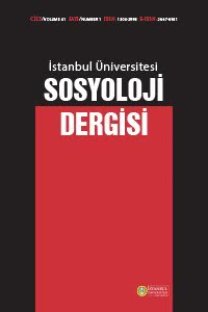The Effect of Settlement Duration on Integration Levels of Turkish Immigrants in Australia
Yerleşim Süresinin Avustralya daki Türk Göçmenlerin Entegrasyon Seviyesine Etkisi
___
- Abadan-Unat, N. (2006). Bitmey en göç: Konuk işçilikten ulus-ötesi y urttaşlığa, İstanbul: Bilgi Üniversitesi. Adıgüzel, Y. (2010). Diyasporadaki kimlik algılamalarına göç tipinin etkisi: Almanya ve İngiltere Türk toplumlarının karşılaştırılması, Sosy oloj i Dergisi, 20, 97-119. Australian Ethnic Affairs Council (1977). Australia as a multicultural society - Submission to the Australian Pop ulation and Immigration Council on the Green p ap er, Immigration p olicies and Australias p op ulation. Canberra: Australian Government Publishing Service. Australian Multicultural Advisory Council (2010). The Peop le of Australia: The Australian Multicultural Advisory Councils Statement on cultural diversity and recommendations to government, n.p. Babacan, H. (2001). Turks. J. Jupp (Ed.), The Australian p eop le, an ency clop edia of the nation: Its p eop le and their origins (pp. 781-782). Cambridge: Cambridge University. Day, A. (2003). Historical dictionary of the discovery and exp loration of Australia. Lanham, Maryland and Oxford: Scarecrow. Eliot, T. S., (1948). Notes towards the def inition of culture. London: Faber&Faber Ltd. de Haas, H. (2007). Migration and development: A theoretical perspective. Paper presented at the conference of Transnationalisation and Development(s): Towards a North-South Perspective, Center for Interdisciplinary Research, Bielefeld, Germany, May 31 - June 01, 2007, (Working Papers Center on Migration, Citizenship and Development; 29) Bielefeld: COMCAD. Icduygu, A. (1994). Facing changes and making choices: Unintended Turkish immigrant settlement in Australia. International Migration, 32, 71- 93. doi: 10.1111/j.1468-2435.1994.tb00516.x İnan, A. M., (2012). Çok-kültürlülük tartışmaları bağlamında Avustralyada yaşayan Türklerin kimlik algısı. Unpublished MA Thesis, Istanbul University. International Organization for Migration, (2010). World Migration Rep ort 2010 The Future Of Migration: Building Cap acities For Change. Geneva: International Organization for Migration. Jupp, J. (2002). From White Australia to Woomera The Story of Australian Immigration. New York: Cambridge University Press. Jupp, J., (2007). The Quest for Harmony. J. Jupp, J. Nieuwenhuysen, and E. Dawson (Ed.), Social Cohesion in Australia (pp. 9-20). New York: Cambridge University Press. Khoo, S., (2011). Intermarriage, integration and multiculturalism: A demographic perspective. J. Jupp and M. Clyne (Ed.), in Multiculturalism and integration: A Harmonious Relationship , (pp. 101-119). Canberra: ANU E Press. Manderson, L. and Inglis, C. (1984). Turkish migration and workforce participation in Sydney, Australia, International Migration Review, 18 (2), 258-275. Markus, A., Jupp, J. and McDonald, P. (2009). Australias immigration revolution. Crows Nest: Allen&Unwin. Ravenstein, E. G. (1889). The laws of migration, Journal of the Royal Statistical Society , 52 (2), 242-305. Stouffer, S. (1940). Intervening opportunities: A theory relating mobility and distance, American Sociological Review, 5 (6), 845-867. Tavan, G., (2005). The long, slow death of White Australia. Carlton North: Scribe. Tekeli, İ. (1975). Göç teorileri ve politikaları arasındaki ilişkiler, OD TÜ Mimarlık Fakültesi Dergisi, 1 (1), 153-176. West, B. and Murphy, F. (2010). A Brief History of Australia. New York: Facts on File Inc.
- ISSN: 1304-2998
- Yayın Aralığı: 2
- Başlangıç: 2020
- Yayıncı: İstanbul Üniv. Edebiyat Fak. Sosyoloji Böl.
British Asian Youth, Urban Protests and Local Belongingness
The Effect of Settlement Duration on Integration Levels of Turkish Immigrants in Australia
Antalya'daki Rus Gelinler: Göçten Evliliğe, Evlilikten Göçe
Karşı İstikametten Göç: Türkiye'deki Yüksek Vasıflı Alman Kadınlar
Avrupa'daki Türkiyeli Göçmenlerin Ulusaşırı Aile Ağları
Ağrılı Göçmenlerin Fransa'ya Tutunma Stratejileri
Transnational Family Networks of Migrants from Turkey in Europe
